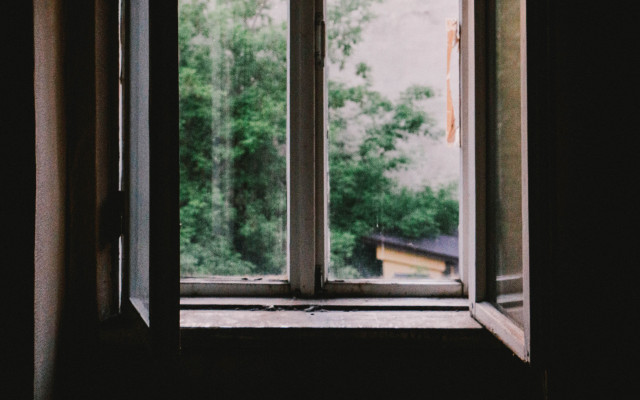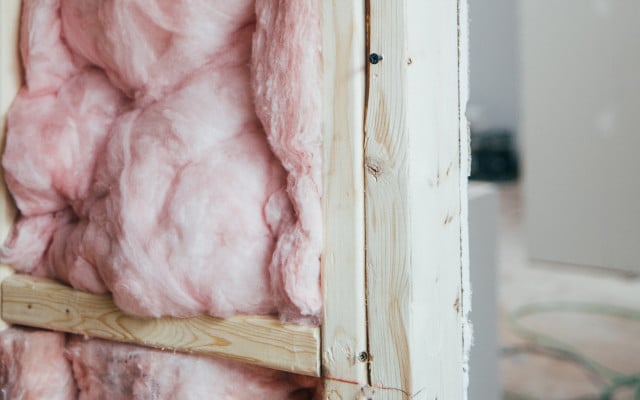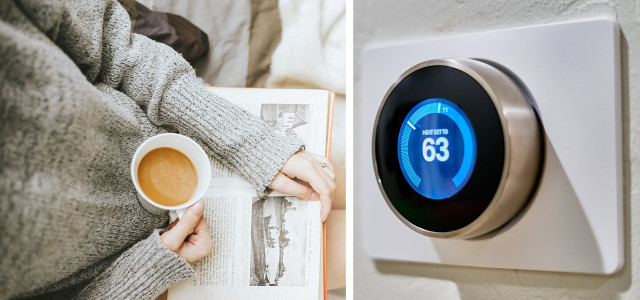Correctly adjust your thermostat settings in winter to save on heating costs and reduce your carbon footprint. Read on to find out the ideal temperature and what else you can do to save money on heating and do something good for the environment.
Take the time to give your thermostat settings a recommended check once in a while. In the US, household heating and cooling are estimated to have made up 43 percent of all energy use in 2022.
This is in part due to a startling statistic: Even though more than 40 percent of households own a thermostat, only one in eight American households use a programmed thermostat to adjust home air conditioning temperature throughout the day.
Read on to find out how you can keep heating costs down and save energy when heating your home by setting the thermostat to the right temperature during the day but also at night. We’ll also explain how you can heat your home while avoiding mold.
1. Recommended Thermostat Settings for Winter Divided by Rooms

Recommended thermostat settings for winter will help in the long run. However, the first step towards saving money on monthly heating costs is often much simpler: heat less, or more sensibly. Setting the thermostat to 78 degrees in your home during winter is downright excessive — and (over)heats your home at the expense of the environment and your heating bills.
The cooler you set your thermostat temperature, the more energy and money you save while heating. According to the U.S. Department of Energy, Americans can save up to ten percent a year on heating and cooling by adjusting thermostats back 7–10 °F for eight hours a day.
- Although the ideal room temperature is, in many cases, a matter of preference, optimal room temperature is usually taken to be somewhere around 66–68 °F.
- It’s okay to let the temperature in the bathroom hover around 71 °F. However, many other rooms in the house require far less heat.
- In the kitchen, the oven and fridge give off their own heat.
- Bedroom temperatures at 62–64 °F are best for sleep. Some of us prefer even less.
Utopia’s tip: Those freezing at night may be better off with a hot-water bottle or a good DIY heating pad rather than jacking up the thermostat temperature.
2. Keep Your Home Warm and Avoid Mold
Don’t let yourself freeze while trying to save energy. Believe it or not — we often start to feel cold at home due to the gradual increases in thermostat temperature settings during winter. When it’s frigid cold outside, and we set the thermostat temperature higher than normal, our bodies adapt to the higher temperature relatively quickly.
If we become accustomed to higher temperatures, this prevents us from noticing when a room is overheated — and even when the thermostat temperature is set just right, we still feel cold.
Rooms you’re not using need little to no heating in the wintertime. That said, try not to let the room temperature drop below 59 °F when outside temperatures are below freezing. Otherwise, you run the risk of developing mold. This is particularly relevant for spaces in your home prone to gathering moisture or in cooler rooms.
Too late? You’ll find mold removal techniques here: Removing Mold: How to Clean Black Mold Effectively
3. When to Adjust your Thermostat Settings for Winter



Once we enter the cooler months of the year, we often ask ourselves when it makes sense to begin heating our homes. To heat our homes sensibly and sustainably, everybody should begin thinking about adjusting their thermostat settings for winter around mid-fall — and not in January.
- Typically, heating days start around October and last until March/April. Projections for the winter of 2022/2023 show more heating days than the past year in October, December and March but fewer than 2021/2022 in November, January and February.
- In many places throughout the US, temperatures are mild enough around the end of April, so heating your home is no longer necessary. This is, of course, dependent on your geographical region and monthly weather patterns.
The coldest months are December through February. These see the majority of winter heating days and thermostat temperatures increase across the board.
To save energy and reduce monthly heating costs, the following rule of thumb is best: Begin increasing your thermostat temperature or heating your home later and stop earlier.
4. Adjust Thermostat Temperatures at Night



Of the US’ total 118.2 million households, 65 percent use central air conditioning. Of those with a programmable thermostat, two-thirds don’t program the thermostat to adjust temperatures at various points throughout the day. Heating an empty living room to midday temperatures overnight or leaving the thermostat at its afternoon average temperature adds to heat waste. It can take a toll on your monthly heating bill (and the environment).
- While nothing speaks against increasing your thermostat to 66–70 °F while you’re home in the daytime, don’t hesitate to drop the thermostat temperature lower at night, even in the winter: 66–62 °F is the recommended thermostat setting for optimal home heating.
- Thermostat settings for winter vary by preference. Find yours and stick to it by either programming your thermostat or manually adjusting it before bed.
- To save energy, close all doors to unused rooms whenever you’re away or at night. This makes it easier for your home’s furnace or heating system to heat only the necessary areas of your house.
Nowadays, in addition to programmable thermostats, there are several smart thermostats available on the market. Primarily available in the form of Wi-Fi-enabled devices, these automatically adjust thermostat temperature settings in your home.
Smart thermostats are also often accompanied by incentives varying by region and energy provider. Consider this worthwhile and sustainable switch to a green home heating management system.
5. Save Energy by Briefly Opening the Windows



Saving energy at home during the heating period doesn’t just involve regular adjustments of thermostat temperature settings during the winter but also proper ventilation. Leaving windows cracked for longer periods hardly helps in letting new air in — it usually only cools down the walls. Inrush airing your home or apartment saves loads of energy and is also good for your health.
- When humidity levels are too low indoors, the body’s mucus membranes begin to dry out. This opens the door to a range of common winter aches, such as dry nose and throat, dry skin and an increased risk of catching a cold.
- When humidity levels are too high, this provides perfect breeding conditions for mold.
Opening your window a couple of times a day for five to ten minutes will ensure proper exchange of air in winter — just remember to adjust the thermostat temperature beforehand.
Already caught a cold? Here are seven effective natural home remedies for colds.
6. Make Sure Your House Is Properly Insulated



Proper adjustments to your thermostat settings for winter have little effect on overall energy use if windows and doors aren’t properly sealed. Proper insulation of your entire building envelope — the part of the house connected to the outdoors — will reduce the wasted heat your home produces and save you money.
Many insulate the attic first, based on the assumption that heat rises. Although this step is important in properly insulating your home, heat moves in all directions. It can be lost easily through air leakage around door and window frames.
Throughout the United States, building codes have become a lot stricter over the years. Nonetheless, plenty of homes are still not properly insulated to fit regional standards. Read over the US Department of Energy’s guide on insulation to make sure your house is well protected from the cold. Recommended thermostat settings are only useful if your home is equipped to retain the heat it produces. This ensures you can maintain a consistent indoor temperature.
Want to learn more about sustainability and the environment? Follow us on Instagram or Twitter!
Read more:
- Organize Your Fridge: How to Choose the Right Temperature and Spot for Your Groceries
- Boost Your Immune System: 10 Ways to Improve Your Natural Defense System
- Seasonal Affective Disorder: How to Conquer Seasonal Depression
Do you like this post?






